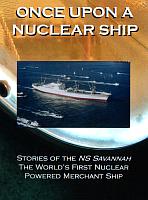 A new documentary by Thomas Michael Conner, “Once Upon a Nuclear Ship,” tells the story of the NS Savannah, the world’s first nuclear powered merchant ship. It is an interesting and worthy tale to tell. Without having seen the documentary, however, the documentary web site seems to suggest that it may be a film targeted at nuclear enthusiasts, at least based on the copy that describes the NS Savannah as “once the diamond in the crown of the US merchant fleet only to be kicked to the curb by dimwitted politicians and bureaucrats.” With all due respects, the reason that the Savannah, in particular, and nuclear merchant ships, in general, did not succeed is a bit more complicated than the actions or in-actions of “dimwitted politicians and bureaucrats.”
A new documentary by Thomas Michael Conner, “Once Upon a Nuclear Ship,” tells the story of the NS Savannah, the world’s first nuclear powered merchant ship. It is an interesting and worthy tale to tell. Without having seen the documentary, however, the documentary web site seems to suggest that it may be a film targeted at nuclear enthusiasts, at least based on the copy that describes the NS Savannah as “once the diamond in the crown of the US merchant fleet only to be kicked to the curb by dimwitted politicians and bureaucrats.” With all due respects, the reason that the Savannah, in particular, and nuclear merchant ships, in general, did not succeed is a bit more complicated than the actions or in-actions of “dimwitted politicians and bureaucrats.”
The film’s trailer also raises concerns. Early on, it states that, “among all those ships who sailed all those seas, there was only one merchant ship powered by atomic energy, the NS Savannah…” That simply isn’t true. The NS Savannah was not the only nuclear merchant ship . The NS Savannah was the first, put into service in 1962. There were, however, three other nuclear power merchant ships, the German Otto Hahn, the Japanese Mutsu and the Russian Sevmorput, which is still in service, more or less. The icebreaker Lenin, which began operation in 1959, claims the title as the first civilian ship with a nuclear power plant.
The Savannah is often described as a “demonstration project” by the US government. Nevertheless, it was evident that the government wanted the ship to operate economically in merchant service, supported by moderate subsidies. The ship was designed in the late 1950s as a “passenger/cargo liner.” Her holds were not particularly large for her size and were designed to carry break-bulk cargo to be loaded and discharged with swinging booms. She also had accommodations for 100 passengers.
Independent of her power supply, when the Savannah went into service in the 1960s, she steamed straight into two revolutionary changes in the shipping. The Boeing 707, introduced in 1958, effectively replaced ships with planes as a means of moving passengers. Likewise, the advent of containerization in the mid 1960’s was to render breakbulk cargo liners obsolete. The Savannah‘s crew of 124 added significantly to her operating costs. The Savannah was laid up in 1971 after traveling 450,000 miles under nuclear power.
The German Otto Hahn, which went into service in 1970, may have been the most successful, or, at least, the closest to successful, nuclear merchant ship. She operated as a passenger carrying ore ship and traveling 650,000 miles under nuclear power. In 1979, her nuclear power plant was removed and she was converted to conventional diesel power. She was converted to a container ship in 1983 and operated as such until she was scrapped in 2009.
The Japanese nuclear merchant ship, Mutsu, was not a success by any standards. Put into service in 1974, she was plagued by reactor leaks. The ship ultimately succeeded in traveling 51,000 miles under nuclear power but over 25 years cost more than 120 billion yen or approximately US$1.2 billion. The reactor was finally removed in 1995. After decontamination, the Mutsu was rebuilt as the ocean observation vessel Mirai.
The last nuclear powered mercahnt ship and the only one still, notionally, in service, is the Russian Sevmorput, a nuclear-powered icebreaking LASH carrier and container ship, delivered in 1988. Put into service only two years after the Chernobyl disaster, the ship’s operation has been hampered by port protests and high operating costs.
